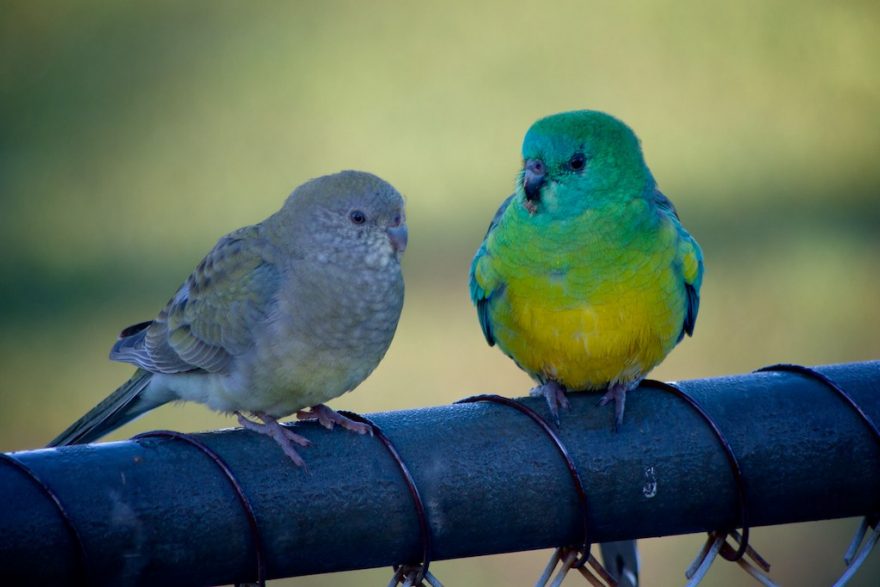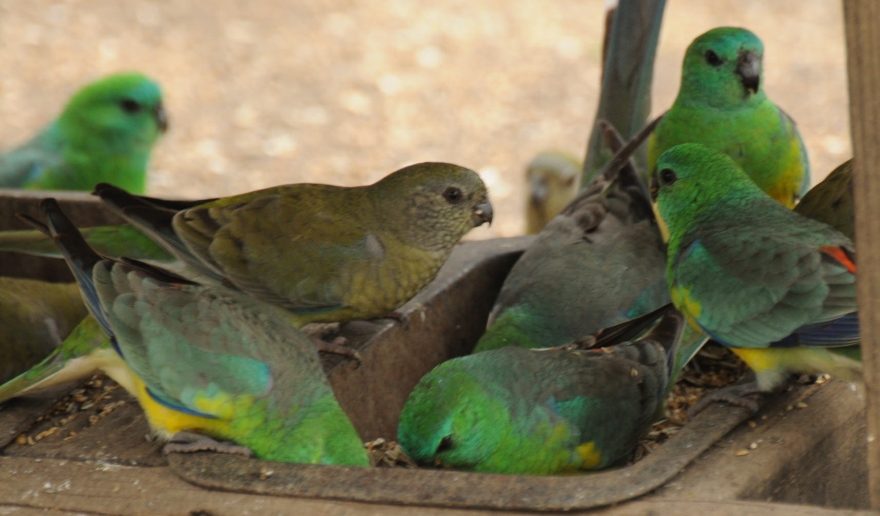The Red-rumped parrot (known also as the grass parrot) is a small parrot found in the south-east of Australia, especially throughout the Murray-Darling Basin. They are very common in aviculture throughout the world, but especially Australia where they’re considered to be an affordable bird suitable for beginners. Many color mutations have been developed including blue, cinnamon, and yellow; causing normal colored birds to become increasingly difficult to acquire.

Diet & Feeding
The basis of the Red-rumped parrot’s diet is a quality small parrot seed mix. Seed is most nutritious when it has been soaked or sprouted. Commercial pellets can be offered as a substitute for dry seed, however Red-rumped parrots have a reputation for being unwilling to consume pelleted food.
Green seeding grasses are the major food source of wild Red-rumped parrots and should be offered to captive birds. Unless the aviary is immensely large and grasses can grow faster than the birds can consume them, it will be necessary to grow grasses in pots which can be rotated out to allow the plant to recover. Planting some of their dry seed is the easiest way to acquire non-toxic seeding grasses.
Red-rumped parrots should be provided with a wide variety of fruit and vegetables. Green leafy vegetables such as kale, bok choy, and endive are especially important. Apple, pear, corn, carrot and broccoli are readily consumed. As with all birds; Avocado, chocolate, caffeine and alcohol are toxic and should not be fed.
Some birds may consume insects, particularly when there are chicks in the nest. Mealworms are generally the easiest live food to acquire and will be readily consumed by insect-eating birds.
Housing & Compatibility
Red-rumped parrots can be aggressive and should be housed as one pair per aviary. An aviary of at least two meters (6.5ft) should be used to provide adequate space for flying. Double wiring is a necessity if there is an adjoining aviary, as Red-rumps will attack other birds through wire.
Red-rumped parrots enjoy foraging on the ground so traditional aviaries are preferred over suspended flights. The substrate of the aviary should be kept clean and dry to reduce the likelihood that the bird contracts a disease or parasite.
Natural perches and leafy branches (ideally from Eucalyptus trees) can be provided as entertaining for the birds, and to provide natural beak and feet exercise. Red-rumps will be destructive to foliage in a planted aviary.

Breeding
Red-rumped parrots will typically commence breeding during their second year. The breeding season begins in spring and continued through to early summer, however autumn breeding is not unheard of.
A medium sized nesting box or hollow log will be used. Red-rumped parrots can produce up to three clutches per year, each containing between 3-6 young. Eggs are incubated for approximately three and a half weeks and fledge the nest at five weeks of age. They become fully independent 3-4 weeks later.
The hen is primarily responsible for incubating the eggs and raising the young, while the male enters the nestbox only to feed the hen. Young birds will need to be removed from the aviary once they become independent, as the cock bird is quite aggressive and may injure or kill his young.
Sexing
Red-rumped parrots are very easy to sex. The males have vivid green, yellow and blue plumage, while the females are a drab greenish-grey colour.
Health
As a grass parrot species, the Red-rumped parrot spends a substantial amount of time foraging at ground level. Keeping the aviary substrate dry and clean (free from droppings) is very important. A strict worming and parasite control regime should be utilized as a preventative measure.
A healthy Red-rumped parrot has a life expectancy of fifteen to twenty years.
can I keep two red rump hens together.
Depending on the size of the Aviary Joanne. What size is it ? Typically, the answer is No – as most hens will squabble & attack each other …..if they feel that 2 is company & three [ in the size of the aviary ] is a crowd. 🙂
Hi, have just finished a new avairy, currently populated with a pair of Scarlet Parrots and 2 pair of Gouldians, will the introduction of a pair of Red Rumped Parrots cause problems ?
Regards,
Col
Quite likely.
I have a red rump matation male I have a female ground parrot the male won’t let her near him the pet shop told me the can mate I’ve had them for 2 days
Are the Red Rumped parrots aggressive during breeding ?
Especially during breeding, yes; but they also have personal space issues throughout the year.
Shane, thank you for your advice, will stick to the Scarlets and Rosey Burkes
Hi there Guys & Gals, I would like to make contact with fellow aviculturists who have developed a solid line of Rubino Red Rump Grass Parrots & similarily the Opaline’s which have developed a predominantaly full red plumage coverage. I live in South Sydney & are particularly keen on building up STRONG specimans of 3 strains of Red Rump Grass Parrots. The previous two previously mentioned & Lutino Lime Blue Opalines [ with the pale blue” frosting ” edging through what is otherwise a White Grass Parrot ]. Cheers, Dave
Just purchased a pair of Red Rumps and have started matng straight away in mid Autumn…Hopefully all goes well..
I have two pair that don’t seem to Nobel interestedly in breeding,one pair ,white with slight blue wings the other white with blue wings,also I have a trio of Turquoise when I brought them I was told they are also grass parrots but they are a little smaller that my other grassies ,as you can see I am new at this just need to know how to roll the sex of the birds
Thanks.
Hi, a tree branch came down in the wind last night and a bunch of eggs rolled out. Most were dead but one chick had just pipped. It’s now out of it’s shell. I can order a parrot feed online but need advice as to what to try feeding it till then. I’m thinking to blitz small parrot seed and some grasses with a bit of spinach – will that do as a stop gap? Cheers,